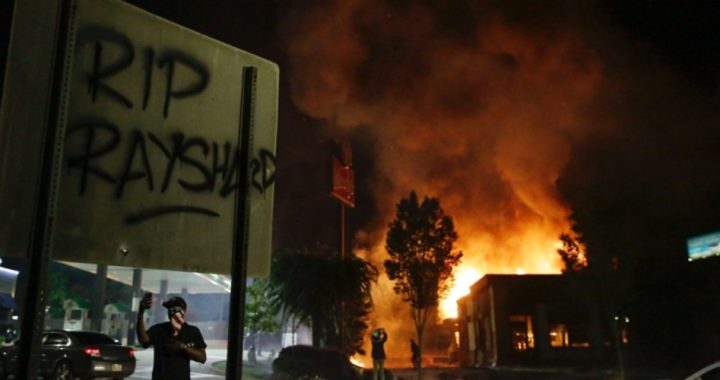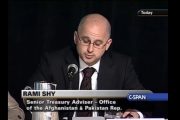
Amid all the protests — some peaceful, others violent — in the wake of the death of George Floyd at the hands of a Minneapolis police officer, police in Atlanta shot and killed Rayshard Brooks on Friday. The death of another black man at the hands of police has added fresh fuel to an already blazing fire.
Around 10:30 p.m. Friday, 27-year-old Brooks was passed out in his car in a drive-through at a Wendy’s on the south side of Atlanta, blocking the drive-through. Store employees called the police and Atlanta Police Department Officer Devin Brosnan responded. After waking Brooks and having him park his car, Brosnan called for backup and was joined by DUI taskforce officer Garrett Rolfe.
When a breathalyzer showed that Brooks — who had attended the first day of his daughter’s two-day celebration for her eighth birthday before visiting his mother’s graveside — was well over the legal limit, they told him he was under arrest and asked him to turn around. At this point, police had been interacting with Brooks for nearly 45 minutes and — as can be seen from body-cam video — the entire interaction was cordial on both sides.
But this is where everything went horribly sideways.
When Rolfe attempted to place handcuffs on Brooks, he resisted, fighting the officers. The struggle went to the ground, and both officers attempted to subdue Brooks. Video from the scene (from both a mobile phone and the store’s surveillance cameras) shows that Brooks punched one of the officers. Brosnan drew his taser and said, “You’re going to get tased! Stop fighting!”
Brooks grabbed for the taser and Brosnan can be heard warning him, “Hands off the taser.” Brooks managed to get the taser away from the officer and then ran away, with the officers chasing him. In the video, Rolfe can be seen firing his taser at Brooks, but Brooks — appearing unfazed — continues to run. He then turns, points his stolen taser at Rolfe and fires, missing.
And that is when Rolfe — who, by this time, has spent the better part of an hour with Brooks — drew his sidearm and fired three times at Brooks. Two of those shots hit Brooks in the back, leading to organ damage and blood loss that would end his life.
Saturday was to be the second day of his daughter’s celebration, and Brooks was supposed to take her skating. Saturday morning, she put on her favorite dress for the day and then learned that her dad would not be there. He was dead.
His death is a tragedy. It shattered a family; Brooks was married with three children and a stepchild. He appears by all accounts to have been devoted to his family.
Rolfe has been fired and will likely be charged. Brosnan has been placed on administrative leave. The police chief has resigned. BLM and others have called this another murder of a black man by white police officers. The coroner ruled the death a homicide. Many have said that resisting arrest should not carry an immediate death sentence. It has been compared to the recent death of George Floyd, since both were black men killed by white officers.
Not surprisingly in these troubled times, riots and looting have broken out in Atlanta. That Wendy’s was burned to the ground. Property has been stolen. Still more has been destroyed. Scores of arrests have been made. Atlanta is tense and people are afraid.
There are some things in this shooting that are similar to the death of George Floyd, and some things that are very different. This is not that. The death of Floyd — pinned to the ground by officer Derek Chauvin’s knee applied to his neck for nearly nine minutes while he repeatedly told Chauvin, “I can’t breathe!” is pretty clear cut. This is not.
The similarities are made up of the fact that Brooks and Floyd were both black and the officers who killed them were both white. While that is true, it is also irrelevant. Because it is also true that there is exactly zero evidence that either killing was motivated by the ethnicity of either of the police officers or either of the men who were killed.
The differences are more striking.
When George Floyd was killed, he had already been subdued. He was in handcuffs and was not resisting; in fact, he was unable to. He was slowly, painfully, frighteningly suffocated to death while not able to do anything about it.
Brooks was resisting — to the point of actually striking officers with his fists (injuring one of them) and taking a weapon from one of them. He ran with that weapon. He was tased and kept running (more about another case from the past that shares a similarity with this point). He fired a police taser at one of the officers.
While it can certainly be argued that Rolfe did not have to use lethal force (and in fact, that use violated department guidelines), it is important to remember that Brooks had just physically bested two officers and attempted to incapacitate one of them with a taser. If he had been successful, it would have been one-on-one, and Brooks had already shrugged off being tased.
After the physical fight, where Brooks managed not only to throw to officers off of him, but to wrestle one of their tasers away from them, adrenaline was high. No one can know the state of Rolfe’s mind. Perhaps, after the sudden and unexpected shift in the situation and Brooks’ violence and resistance to non-lethal force (the taser), he felt the stakes were high enough to warrant the use of lethal force.
No one can know the state of mind of Brooks, either. Why did he fight? Why did he run? Why did he fire a taser at a police officer? He had just spent almost an hour in cordial conversation with those officers. He repeatedly referred to Rolfe as “Mr. Rolfe” during that mutually respectful conversation. Why the sudden shift to violence? He was drunk; that much is certain. He had just visited his mother’s grave, which may explain why he had had too much to drink. It is obvious from the facts that he was not thinking clearly.
His actions after he was informed that he was under arrest, his violence, and his resilience to being tased are reminiscent of another episode years ago that resulted in mass riots and looting. On March 3, 1991, Rodney King — who was under the influence of alcohol and suspected of being under the influence of other drugs — led California Highway Patrol (CHP) officers on a chase with speeds up to 117 mph before being forced off the road in a residential neighborhood. By this time, LAPD had joined the pursuit and took over, since they had jurisdiction.
King exited the car and fought officers who attempted to subdue him. He was tased and it appeared to have little effect on him. He charged at the officers, knocking at least one of them to the ground. LAPD and CHP chose to use non-lethal force, striking King dozens of times with batons, hands, and feet. During this time, King continued to fight back, getting up time and again.
The entire episode was caught on video by a resident of the neighborhood, who sent that video to a local news channel. The full video — almost 10 minutes long and showing that King was nearly unable to be subdued, resulting in officers beating him into submission before finally effecting an arrest — was cut to about two minutes when originally aired. This made it appear that police officers were beating King for sport.
When the case went to trial, all police officers were acquitted, due at least in part to the full video, showing that officers had little choice but to use extreme force.
Los Angeles and other cities around the country erupted in riots and looting, with South Central Los Angeles taking the brunt of the damage. King called for the riots to end, famously delivering his “Can’t we all just get along?” speech in a televised appearance.
Again, there are similarities and differences between the King episode and the death of Brooks.
And that is the point. Nothing is exactly like anything else. Each case is its own entity. To make blanket comparisons simply based on the races of the people involved is ignorant, simple-minded, and dangerous.
America does not need more violence in the wake of each episode of police (white, black, or otherwise) killing someone (white, black, or otherwise).
King was certainly no model citizen. He ran that night because a drunk-driving conviction would have violated his parole for a previous armed robbery conviction and he spent the remainder of his life being arrested for drunk driving, drug use, and violence, including hitting his wife with a car.
Still, he said it best even back then: “Can’t we all just get along?” But until race stops leading the headlines and serving as a cause for insurrection, looting, riots, and other violence, the answer to King’s question will remain a resounding “No!”
Photo: AP Images
C. Mitchell Shaw is a freelance writer and public speaker who addresses a range of topics related to liberty and the U.S. Constitution. A strong privacy advocate, he was a privacy nerd before it was cool.




